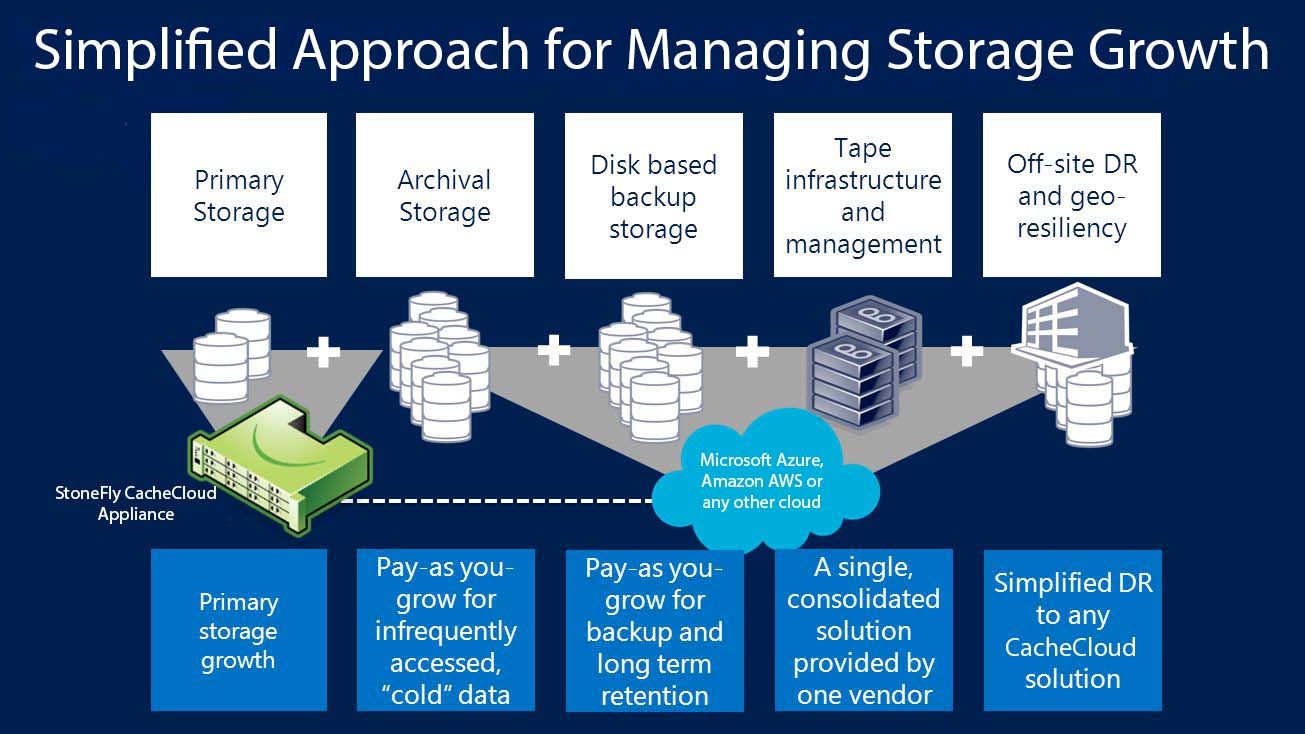The solution also incorporates the innovations of Microsoft Azure Storage in them. Before moving to the solution for enterprise workloads, we look at the workings of a datacenter to see why a datacenter is not as perfect as it seems.
Typical Architecture in Todays Data Centers

A typical data center in today’s world is made up of a;
– Primary Storage
– Backup (Archival; maybe disk or tape based infrastructure)
– Disaster Recovery (Can be off-site for greater geo-resiliency)
A data center is also lined up with various hardware and software solutions that go hand in hand with each of the above components of a typical data center. Sometimes, the end user can find a single vendor which can provide with many of these components. However, the fact remains the same; the management of a data center is very complex as it is very tedious to manage a lot of these features and functions of the solution.
Incorporating CacheCloud in the Architecture
Looking at the growing data generation throughout the world and how enterprises are in need of a storage solution based around reliability and performance, StoneFly has stepped in to provide the best solution. ‘CacheCloud’ is an actual appliance provided by StoneFly, it is a new and unique idea which connects to Microsoft Azure Storage or Amazon AWS. The StoneFly CacheCloud appliances were designed for customers requiring a powerful On-prem Flash based Cache edge Storage solution to provide the fastest On-prem speed while they are using the public cloud such as Amazon AWS and Microsoft Azure for storage.

The solution through which the cloud storage provider steps in takes into its hands various functions like data archival, backup. The end user does not need a tape infrastructure anymore. Moreover, disaster recovery is also accounted for with ease as the end user is provided with disaster recovery in the cloud. Customers are provided with disaster recovery solutions because of the CacheCloud Gateway for Microsoft Azure and Amazon AWS.
CacheCloud confers numerous benefits on its users with its enhanced features.
- Consolidation of the Storage Infrastructure: StoneFly CacheCloud meets the performance and capacity needs of the customers by providing a complete hybrid cloud storage solution for enterprises. Not only does it provide physical arrays for deployment in data centers; it also provides for the smaller enterprise environments which require NAS by providing them virtual arrays. The added on-demand infrastructure that is provided to the customers gives them flexibility. Customers do not have to maintain costly on-premises equipment for new or special projects.
- Automated Data Management: CacheCloud provides its customers with effortless capacity expansion by automatically archiving inactive primary data from on-premises to the cloud. Cloud storage snapshots are also provided to customers that provide off-site protection eliminating the need for remote replication of data. End users can be at ease at meeting their business needs; the focus can shift from maintaining expensive infrastructure to fulfilling the needs of the business.
- Improved Compliance and Accelerated Disaster Recovery: CacheCloud provides customers with greater reliability during partial or full disaster recovery by giving the customers immediate data availability. Customers are at ease due to the use of software policies and not the traditional tape rotations or backup system capacity. CacheCloud allows the customers to fix gaps and fine-tune by testing data recovery and making sure that there is compliance with corporate policies for data retention and disaster recovery.
- Growth of Business through Enhanced IT Agility: CacheCloud helps in increasing the operational efficiency of the business through rapid data movement. Customers are also at ease as IT overheads are reduced. Effective and efficient decisions are hence made; cloud backup and enterprise NAS hence ensures that an organization never suffers great losses while doing business.
- Simplified Architecture: CacheCloud is extremely flexible and provides the customers with ease in management. End users do not need a great number of different components and features; only two are required now: on-premise appliance and StoneFly.
- New Set of Economics: End users will only have to pay for the storage they use; pay as they go. There is hence no over-provisioning of storage because of the scale-out capacity of Microsoft Azure Storage or Amazon AWS. The user can easily get greater storage for archival needs or get greater primary storage.









